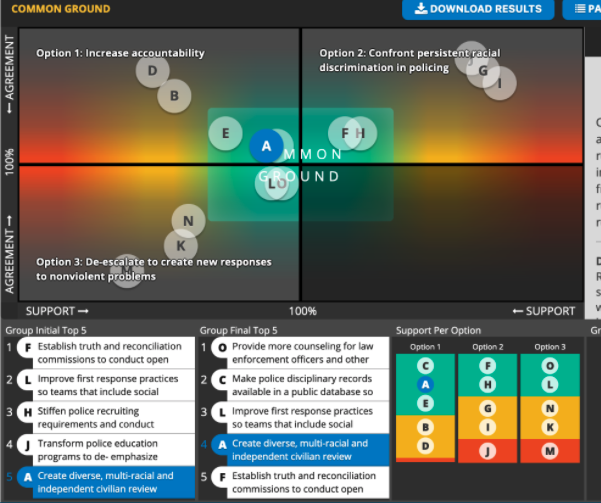How It Works
Common Ground for Action is a scalable, small-group, deliberation-focused software designed for communities, schools and government use
Common Ground for Action (CGA) online forums are small group deliberations, rooted in non-partisan National Issues Forums style issue guides and facilitated by trained moderators. The forums are purposefully small – no more than 12 people participate in a forum. The small size ensures that every participant has a chance to be actively engaged in deliberating as part of the group. The software relies on a group chat for deliberation, which creates an ongoing record of what the group is discussing and how they are grappling with the choices presented in the issue guide. Video conferencing software can supplement the chat and visuals-driven interface to maximize interactions and human connections between participants that spark solutions to joint problems.
The human moderator, who often but not exclusively has a background facilitating in-person deliberative forums, helps tie together chat threads, ask questions that clarify typed posts, and works to ensure participants are engaging with the diversity of comments that participants enter.
See the kind of materials moderators use to facilitate online deliberative forums.
The forum introductory video – 5 minute explainer on how a online deliberative forum works
The forum lobby screen. Moderators and participants start their deliberative experience here by engaging in small talk, sharing stories, and talking about why the issue is important.
How does a CGA forum work?
After the lobby, participants are asked to register their initial thoughts about acceptable action. This allows the moderator to help participants see how much the group’s views change during the course of deliberating together. After registering their baselines ideas, participants individually rank whether they can accept, are conflicted about, or cannot accept an action – but are also asked to consider the potential drawbacks that result from their initial choices.
Once rankings have been complete, moderators then open the forum up for deliberation by showing participants the graphic that represents the judgments of the group. The moderator then uses the visual to spur participants to deliberate, to make choices together based on what they can support and agree on, but also to work through what actions leave participants conflicted.
At the end of the forum, the group reflects on the stories, ideas and choices the group has worked through, and identifies the values behind the found and created common ground across all of the options as well as the impact deliberating had on their views.
Perhaps the most important contribution our software makes to online deliberation is the unique way it visualizes the group’s choice-work. The graphic displays participants’ shifting preferences and provides a powerful opportunity to focus on found and created common ground. And because participants can register their opinion change at any time by re-evaluating their judgments, the visual shifts in real time, reflecting dynamically how the group’s thinking changes when deliberative moments happen. Even though our culture tends to over-emphasize how polarized we are, the chat feature and visuals-driven deliberation helps participants acknowledge disagreement while giving equal attention to areas where people do agree. Because the graphic shows the diversity of views in a room, it can help encourage those who might not normally attend a deliberative forum to participate in their democracy, everyday.
Future enhancements and developments for the software include:
- Integrating audio and video options
- Enhancing the gala forum experience so moderators can manually or automatically balance small breakout forums
- Streamline the forum scheduling process for moderators and allow for integrated calenders and reminders for participants
- Making the chat window larger for more effective deliberation
- Mobile optimized and friendly experience
Example of the deliberation section of a online deliberative forum. Here participants see what common ground they have and can chat with others about their choices.



